| 中文名稱 | α型-過氧化酶活化增生受體抗體 |
| 別 名 | hPPAR; MGC2237; MGC2452; NR1C1; Nuclear receptor subfamily 1 group C member 1; Peroxisome Proliferator Activated Receptor alpha; PPAR; OTTHUMP00000197740; OTTHUMP00000197741; Peroxisome proliferator-activated receptor alpha; PPAR-alpha; PPARA_HUMAN; PPARalpha. |
| 研究領(lǐng)域 | 腫瘤 免疫學(xué) 信號(hào)轉(zhuǎn)導(dǎo) 轉(zhuǎn)錄調(diào)節(jié)因子 激酶和磷酸酶 |
| 抗體來源 | Rabbit |
| 克隆類型 | Polyclonal |
| 交叉反應(yīng) | Human, Mouse, Rat, (predicted: Chicken, Pig, Cow, Horse, Rabbit, ) |
| 產(chǎn)品應(yīng)用 | WB=1:500-2000 ELISA=1:500-1000 IHC-P=1:100-500 IHC-F=1:100-500 Flow-Cyt=1μg /test IF=1:100-500 (石蠟切片需做抗原修復(fù)) not yet tested in other applications. optimal dilutions/concentrations should be determined by the end user. |
| 分 子 量 | 51kDa |
| 細(xì)胞定位 | 細(xì)胞核 |
| 性 狀 | Liquid |
| 濃 度 | 1mg/ml |
| 免 疫 原 | KLH conjugated synthetic peptide derived from human PPAR alpha:301-400/468 |
| 亞 型 | IgG |
| 純化方法 | affinity purified by Protein A |
| 儲(chǔ) 存 液 | 0.01M TBS(pH7.4) with 1% BSA, 0.03% Proclin300 and 50% Glycerol. |
| 保存條件 | Shipped at 4℃. Store at -20 °C for one year. Avoid repeated freeze/thaw cycles. |
| PubMed | PubMed |
| 產(chǎn)品介紹 | Peroxisome proliferators are nongenotoxic carcinogens which are purported to exert their effect on cells through their interaction with members of the nuclear hormone receptor family, termed Peroxisome Proliferator Activated Receptors (PPARs). Nuclear hormone receptors are ligand dependent intracellular proteins that stimulate transcription of specific genes by binding to specific DNA sequences following activation by the appropriate ligand. Studies indicate that PPARs are activated by peroxisome proliferators such as clofibric acid, nafenopin, and WY-14,643, as well as by some fatty acids. It has also been shown that PPARs can induce transcription of acyl coenzyme A oxidase and cytochrome P450 A6 (CYP450 A6) through interaction with specific response elements. PPAR alpha is activated by free fatty acids including linoleic, arachidonic, and oleic acids. Induction of peroxisomes by this mechanism leads to a reduction in blood triglyceride levels. PPAR alpha is expressed mainly in skeletal muscle, heart, liver, and kidney and is thought to regulate many genes involved in the beta-oxidation of fatty acids. Activation of rat liver PPAR alpha has been shown to suppress hepatocyte apoptosis. PPAR alpha, like several other nuclear hormone receptors, heterodimerizes with retinoic X receptor (RXR) alpha to form a transcriptionally competent complex. Function: Ligand-activated transcription factor. Key regulator of lipid metabolism. Activated by the endogenous ligand 1-palmitoyl-2-oleoyl-sn-glycerol-3-phosphocholine (16:0/18:1-GPC). Activated by oleylethanolamide, a naturally occurring lipid that regulates satiety (By similarity). Receptor for peroxisome proliferators such as hypolipidemic drugs and fatty acids. Regulates the peroxisomal beta-oxidation pathway of fatty acids. Functions as transcription activator for the ACOX1 and P450 genes. Transactivation activity requires heterodimerization with RXRA and is antagonized by NR2C2. Subunit: Heterodimer; with RXRA. This heterodimerization is required for DNA binding and transactivation activity. Interacts with AKAP13, LPIN1 and PRDM16. Also interacts with PPARBP coactivator in vitro. Interacts with CITED2; the interaction stimulates its transcriptional activity. Interacts with NCOA3 and NCOA6 coactivators. Interacts with ASXL1 AND ASXL2. Subcellular Location: Nucleus. Tissue Specificity: Skeletal muscle, liver, heart and kidney. Similarity: Belongs to the nuclear hormone receptor family. NR1 subfamily. Contains 1 nuclear receptor DNA-binding domain. SWISS: Q07869 Gene ID: 5465 Database links: Entrez Gene: 5465 Human Entrez Gene: 19013 Mouse Entrez Gene: 25747 Rat Omim: 170998 Human SwissProt: Q07869 Human SwissProt: Q6I9S0 Human SwissProt: P23204 Mouse SwissProt: Q542P9 Mouse SwissProt: P37230 Rat Unigene: 103110 Human Unigene: 710044 Human Unigene: 212789 Mouse Unigene: 9753 Rat Important Note: This product as supplied is intended for research use only, not for use in human, therapeutic or diagnostic applications. |
| 產(chǎn)品圖片 | 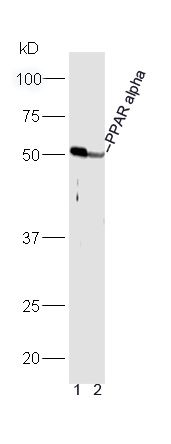 Sample: Sample:Lane1: Heart(Mouse) Lysate at 30 ug Lane2: Liver(Mouse) Cell Lysate at 30 ug Primary: Anti-PPAR alpha (bs-3614R) at 1:300 dilution; Secondary: HRP conjugated Goat-Anti-rabbit IgG(bs-0295G-HRP) at 1: 5000dilution; Predicted band size: 51 kD Observed band size: 51 kD 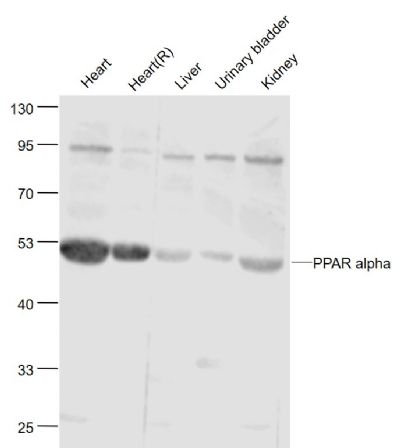 Sample: Sample:Heart (Mouse) Lysate at 40 ug Heart (Rat) Lysate at 40 ug Liver (Mouse) Lysate at 40 ug Urinary bladder (Mouse) Lysate at 40 ug Kidney (Mouse) Lysate at 40 ug Primary: Anti- PPAR alpha (bs-3614R) at 1/1000 dilution Secondary: IRDye800CW Goat Anti-Rabbit IgG at 1/20000 dilution Predicted band size: 52/19 kD Observed band size: 52 kD 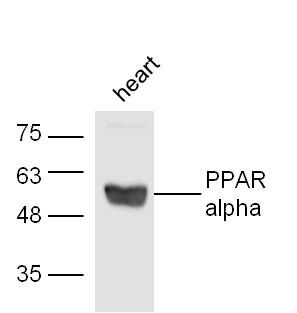 Sample: Heart (Mouse) Lysate at 40 ug Sample: Heart (Mouse) Lysate at 40 ugPrimary: Anti- PPAP alpha (bs-3614R) at 1/300 dilution Secondary: IRDye800CW Goat Anti-Rabbit IgG at 1/10000 dilution Predicted band size: 51 kD Observed band size: 51 kD 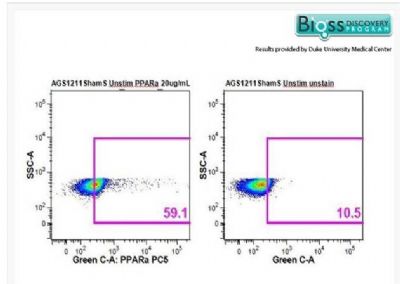 Rat splenocytes stained with Anti-PPAR alpha Polyclonal Antibody, PE-CY5 Conjugated (bs-3614R-PE-Cy5) at 1:50. Rat splenocytes stained with Anti-PPAR alpha Polyclonal Antibody, PE-CY5 Conjugated (bs-3614R-PE-Cy5) at 1:50.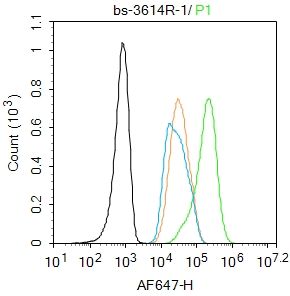 Blank control: HepG2. Blank control: HepG2.Primary Antibody (green line): Rabbit Anti-PPAR alpha antibody (bs-3614R) Dilution: 1μg /10^6 cells; Isotype Control Antibody (orange line): Rabbit IgG . Secondary Antibody : Goat anti-rabbit IgG-AF647 Dilution: 1μg /test. Protocol The cells were fixed with 4% PFA (10min at room temperature)and then permeabilized with 90% ice-cold methanol for 20 min at -20℃. The cells were then incubated in 5%BSA to block non-specific protein-protein interactions for 30 min at room temperature .Cells stained with Primary Antibody for 30 min at room temperature. The secondary antibody used for 40 min at room temperature. Acquisition of 20,000 events was performed. |
我要詢價(jià)
*聯(lián)系方式:
(可以是QQ、MSN、電子郵箱、電話等,您的聯(lián)系方式不會(huì)被公開)
*內(nèi)容:









